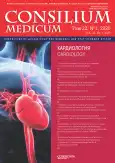POSSIBILITIES OF RESIDUAL DYSLIPIDEMIA CORRECTION IN PATIENTS WITH MULTIFOCAL ATHEROSCLEROSIS, WHO ARE RECEIVING OPTIMAL STATIN THERAPY
- Authors: Bogdanov A.R.1,2,3, Pyko M.E.4, Pyko A.A.5,6
-
Affiliations:
- Pirogov Russian National Research Medical University
- Russian State Social University
- City Clinical Hospital №13, Moscow
- Federal Research Centre of Nutrition and Biotechnology
- Pavlov Ryazan State Medical University
- Medical unit of the Ministry of Internal Affairs of Russia in the Ryazan Region
- Issue: Vol 22, No 1 (2020)
- Pages: 54-60
- Section: Articles
- URL: https://journals.rcsi.science/2075-1753/article/view/95211
- DOI: https://doi.org/10.26442/20751753.2020.1.200057
- ID: 95211
Cite item
Full Text
Abstract
Full Text
##article.viewOnOriginalSite##About the authors
Alfred R. Bogdanov
Pirogov Russian National Research Medical University; Russian State Social University; City Clinical Hospital №13, Moscow
Email: bogdanov.ar@mail.ru
д-р мед. наук, проф. каф. факультетской терапии Москва, Россия
Mary E. Pyko
Federal Research Centre of Nutrition and Biotechnologyаспирант Москва, Россия
Andrei A. Pyko
Pavlov Ryazan State Medical University; Medical unit of the Ministry of Internal Affairs of Russia in the Ryazan Regionканд. мед. наук, проф. каф. факультетской терапии Рязань, Россия
References
- Kandaswamy E, Zuo L. Recent advances in treatment of coronary artery disease: role of science and technology. Int J Mol Sci 2018; 19 (2): 424.
- Roger VL, Go AS, Lloyd-Jones DM et al. Heart disease and stroke statistics 2012 update: a report from the American Heart Association. Circulation 2012; 3; 125 (1): 2-220.
- Шальнова С.А., Деев А.Д. Ишемическая болезнь сердца в России: распространенность и лечение (по данным клинико-эпидемиологических исследований). Т ерапевтический архив. 2011; 83 (1): 7-12.
- Балева Е.С. Оценка качества жизни в ракурсе оптимизации медико-социальной реабилитации больных ишемической болезнью. Автореф. дис.. канд. мед.наук. Волгоград, 2011.
- Nabel EG, Braunwald E. A tale of ooronary artery disease and myocardial infarction. N Engl J Med 2012; 366 (1): 54-63.
- Tomiyama H, Matsumoto C, Shiina et al. Brachial-ankle PWV: current status and future directions as a useful marker in the management of cardiovascular disease and/or cardiovascular risk factors. J Atheroscler Thromb 2016; 23 (2): 128-46.
- Морозова Т.Е., Вартанова О.А. Статины в лечении и профилактике прогрессирования атеросклероза у больных с ишемической болезнью сердца. Кардиосоматика. 2013; 1: 28-35.
- Lee SE, Chang HJ, Sung JM et al. Effects of statins on coronary atherosclerotic plaques: the PARADIGM study. JACC: Cardiovasc Imaging 2018; 11 (10): 1475-84.
- Бойцов С.А., Погосова Н.В., Бубнова М.Г. и др. Кардиоваскулярная профилактика 2017. Российские национальные рекомендации. Кардиоваскулярная профилактика. 2018; 6: 7-122.
- Гусев А. А. Сравнительное изучение биологических свойств сапонинов. Ветеринария. 1980; 1: 26.
- Turgeon RD, Pearson GJ. Proprotein convertase subtilisin/kexin type 9 inhibitors for reduction of cardiovascular events. Am J Health Syst Pharm 2018; 75 (11): 747-54.
- Saborowski M, Dolle M, Manns MP et al. Lipid-lowering therapy with PCSK9-inhibitors in the management of cardiovascular high-risk patients: Effectiveness, therapy adherence and safety in a real world cohort. Cardiol J 2018; 25 (1): 32-41.
- Шулутко И.Б., Тугбаева Л.Я., Нестеров В.А. Терапевтическая эффективность сапонинов диоскореи при лечении больных атеросклерозом. В кн.: Лекарственные средства из растений. Под ред. А.Д.Туровой. М., 1962; с. 143.
- Милимовка М.Е., Коновалов М.Н, Рыбников М.И., Димат М.И. Опыт лечения больных атеросклерозом полиспонином. Врач. дело. 1963; 1.
Supplementary files






